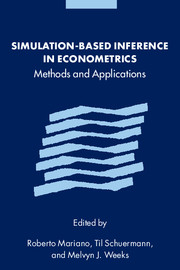Book contents
- Frontmatter
- Contents
- List of contributors
- Foreword by M. Hashem Pesaran
- Part I Simulation-based inference in econometrics: methods and applications
- Part II Microeconometric methods
- Part III Time series methods and models
- Part IV Other areas of application and technical issues
- Introduction
- 12 A comparison of computational methods for hierarchical models in customer survey questionnaire data
- 13 Calibration by simulation for small sample bias correction
- 14 Simulation-based estimation of a non-linear, latent factor aggregate production function
- 15 Testing calibrated general equilibrium models
- 16 Simulation variance reduction for bootstrapping
- Index
15 - Testing calibrated general equilibrium models
Published online by Cambridge University Press: 04 August 2010
- Frontmatter
- Contents
- List of contributors
- Foreword by M. Hashem Pesaran
- Part I Simulation-based inference in econometrics: methods and applications
- Part II Microeconometric methods
- Part III Time series methods and models
- Part IV Other areas of application and technical issues
- Introduction
- 12 A comparison of computational methods for hierarchical models in customer survey questionnaire data
- 13 Calibration by simulation for small sample bias correction
- 14 Simulation-based estimation of a non-linear, latent factor aggregate production function
- 15 Testing calibrated general equilibrium models
- 16 Simulation variance reduction for bootstrapping
- Index
Summary
Introduction
Simulation techniques are now used in many fields of applied research. As shown elsewhere in this book, they have been employed to compute estimators in situations where standard methods are impractical or fail, to evaluate the properties of parametric and non-parametric econometric estimators, to provide a cheap way of evaluating posterior integrals in Bayesian analysis and to undertake linear and non-linear filtering with a computationally simple approach.
The task of this chapter is to describe how simulation-based methods can be used to evaluate the fit of dynamic general equilibrium models specified using a calibration methodology, to compare and contrast their usefulness relative to more standard econometric approaches and to provide an explicit example where the various features of the approach can be highlighted and discussed.
The structure of this chapter is as follows. First, we provide a definition of what we mean by calibrating a model and discuss the philosophy underlying the approach and how it differs from standard dynamic time series modeling. Second, we discuss various approaches to the selection of model parameters, how to choose the vector of statistics used to compare actual with simulated data and how simulations are performed. Third, we describe how to formally evaluate the model's approximation to the data and discuss alternative approaches to account for the uncertainty faced by a simulator in generating time paths for the relevant variables. Although we present a general overview of alternative evaluation techniques, the focus is on simulation-based methods.
Information
- Type
- Chapter
- Information
- Simulation-based Inference in EconometricsMethods and Applications, pp. 400 - 436Publisher: Cambridge University PressPrint publication year: 2000
Accessibility standard: Unknown
Why this information is here
This section outlines the accessibility features of this content - including support for screen readers, full keyboard navigation and high-contrast display options. This may not be relevant for you.Accessibility Information
- 6
- Cited by
